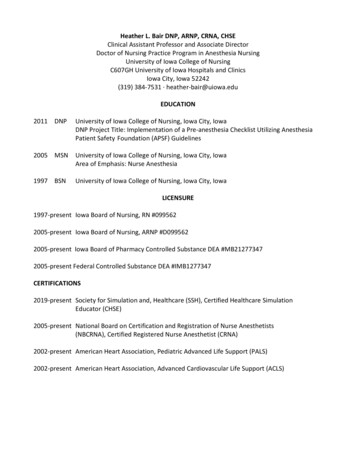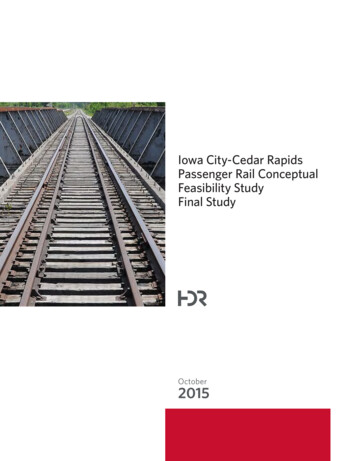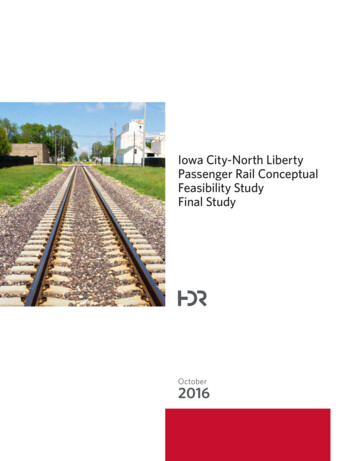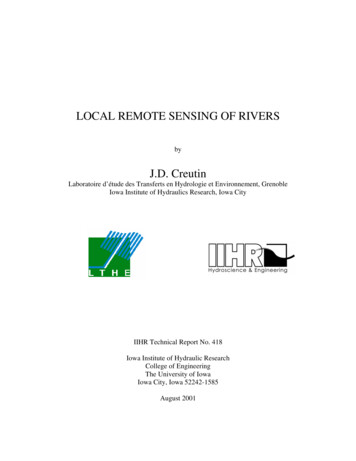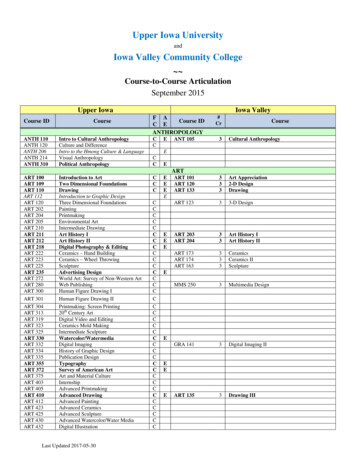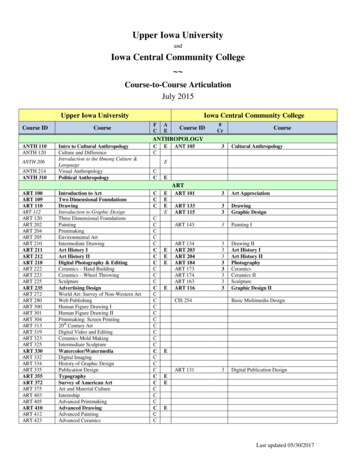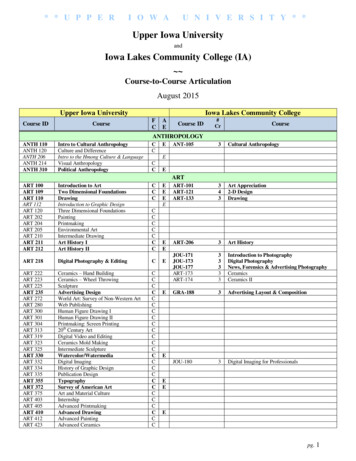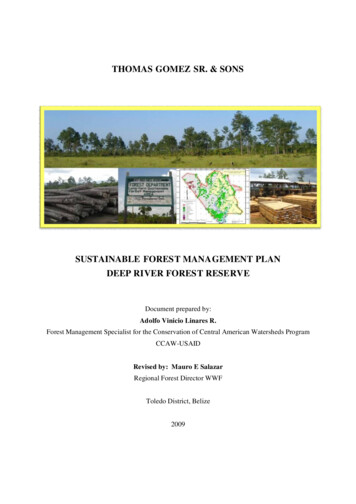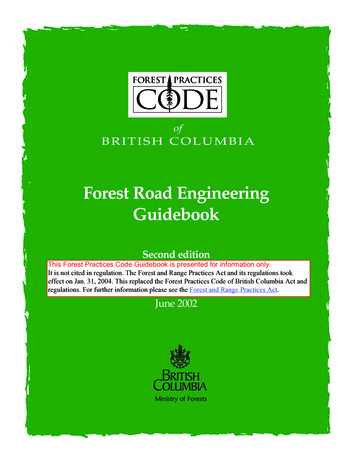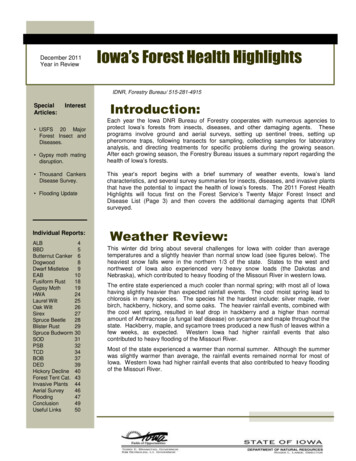
Transcription
. IDecember 2011Year in ReviewIowa’s Forest Health HighlightsIDNR, Forestry Bureau/ 515-281-4915SpecialArticles:Interest USFS 20 MajorForest Insect andDiseases. Gypsy moth matingdisruption. Thousand CankersDisease Survey. Flooding UpdateIndividual Reports:ALBBBDButternut CankerDogwoodDwarf MistletoeEABFusiform RustGypsy MothHWALaurel WiltOak WiltSirexSpruce BeetleBlister RustSpruce BudwormSODPSBTCDBOBDEDHickory DeclineForest Tent Cat.Invasive PlantsAerial SurveyFloodingConclusionUseful 4950Introduction:Each year the Iowa DNR Bureau of Forestry cooperates with numerous agencies toprotect Iowa’s forests from insects, diseases, and other damaging agents. Theseprograms involve ground and aerial surveys, setting up sentinel trees, setting uppheromone traps, following transects for sampling, collecting samples for laboratoryanalysis, and directing treatments for specific problems during the growing season.After each growing season, the Forestry Bureau issues a summary report regarding thehealth of Iowa’s forests.This year’s report begins with a brief summary of weather events, Iowa’s landcharacteristics, and several survey summaries for insects, diseases, and invasive plantsthat have the potential to impact the health of Iowa’s forests. The 2011 Forest HealthHighlights will focus first on the Forest Service’s Twenty Major Forest Insect andDisease List (Page 3) and then covers the additional damaging agents that IDNRsurveyed.Weather Review:This winter did bring about several challenges for Iowa with colder than averagetemperatures and a slightly heavier than normal snow load (see figures below). Theheaviest snow falls were in the northern 1/3 of the state. States to the west andnorthwest of Iowa also experienced very heavy snow loads (the Dakotas andNebraska), which contributed to heavy flooding of the Missouri River in western Iowa.The entire state experienced a much cooler than normal spring; with most all of Iowahaving slightly heavier than expected rainfall events. The cool moist spring lead tochlorosis in many species. The species hit the hardest include: silver maple, riverbirch, hackberry, hickory, and some oaks. The heavier rainfall events, combined withthe cool wet spring, resulted in leaf drop in hackberry and a higher than normalamount of Anthracnose (a fungal leaf disease) on sycamore and maple throughout thestate. Hackberry, maple, and sycamore trees produced a new flush of leaves within afew weeks, as expected. Western Iowa had higher rainfall events that alsocontributed to heavy flooding of the Missouri River.Most of the state experienced a warmer than normal summer. Although the summerwas slightly warmer than average, the rainfall events remained normal for most ofIowa. Western Iowa had higher rainfall events that also contributed to heavy floodingof the Missouri River.
Iowa’s Forest Health HighlightsPage 2 of 50Weather Review Continued:Images provided by Midwest Climate Watch http://mcc.sws.uiuc.edu/cliwatch/watch.htm.
Iowa’s Forest Health HighlightsPage 3 of 50Land Characteristics:Iowa has approximately 3.1 million acres of forested land representing a steady increase over thepast few decades. Most of Iowa’s forests are native hardwood with oak, hickory, maple,basswood, walnut, ash, elm, cottonwood and many other hardwood species. Less than 3% ofIowa’s forests are conifer forests.Even though Iowa’s forests are increasing in acreage, the oak component is decreasing in someareas of the state, as forest succession drifts toward more shade-tolerant species, such asmaple, in the absence of forest disturbance. There are currently 1.15 million acres of oak-forestin Iowa. Succession to shade tolerant hardwoods eventually replaces shade intoleranthardwoods, like oak, in the absence of disturbance. An annual decrease of 6,800 acres of redand white oak from 2003-2008 has been observed. This is an alarming trend.Currently, there are 186 businesses in Iowa which utilize the wood grown in Iowa’s forests. Theforest products industry contributes over 3.9 billion each year to Iowa’s economy, including over18,000 jobs for Iowans (Analysis by E.M. (Ted) Bilek, Economist, USDA Forest Service, ForestProducts Laboratory, Madison, WI). Additional detail can be found on page 192 of Iowa’s ForestsAction Plan.United States Forest Service List of Twenty Major Forest Insectsand Diseases(This is a national list; pests highlighted in red do not pertain to Northern Area and do not need tobe reported on.)Asian long-horned beetleBeech bark diseaseButternut cankerDogwood anthracnoseDwarf mistletoesEmerald ash borerFusiform rustGypsy mothHemlock woolly adelgidLaurel wilt disease/redbay ambrosia beetleMountain pine beetleOak wiltSirex woodwaspSouthern pine beetleSpruce beetleSpruce budwormSudden oak deathWhite pine blister rustWestern bark beetlesWestern spruce budwormPlus:Tomicus beetle or pine shoot beetle
Iowa’s Forest Health HighlightsPage 4 of 50Twenty Major Forest Insects and Diseases: Asian longhorned beetleYearState:2011IowaForest PestCommon Name: Asian long-horned beetleScientific Name: Anoplophora glabripennisHosts: Maple, horsechestnut/buckeye, willow, elm, birch and sycamore.Setting:N/ACounties:N/ASurvey Methods:N/AAcres Affected:N/ANarrative:Asian long-horned beetle has not been identified in Iowa. Noadditional funds were available to conduct survey work. Nosuspect samples were submitted to IDNR or the ISU PlantDiagnostic Clinic. No other survey work was conducted forAsian long-horned beetle. If beetles are found (Figure 1.) contactChristine Markham (USDA National Coordinator) at 919-8557328 and Robin Pruisner (State Entomologist) at 515-725-1465.http://www.aphis.usda.gov/plant health/plant pest info/asian lhb/index.shtml.Figure 1. Adult Asian long-horned Beetle (Image: Dennis Haugen, USDA Forest Service,Bugwood.org).
Iowa’s Forest Health HighlightsPage 5 of 50Twenty Major Forest Insects and Diseases: Beech BarkDiseaseYearState:2011IowaForest PestCommon Name: Beech bark diseaseScientific Name: Nectria coccinea var. faginataHosts: American Beech.Setting:N/ACounties:N/ASurvey Methods:N/AAcres Affected:N/ANarrative:American beech is not a native tree to Iowa. Iowa is well outsideof the native range of American beech and no survey work wasconducted for beech bark disease. If a landowner has beechtrees that they believe have beech bark disease please contactTivon Feeley (IDNR Forest Health Program Leader) at 515-2814915 or Robin Pruisner (State Entomologist) at eechbark/fidl-beech.htm.Figure 2. Beech bark disease “tarry spot” or flux. (Image: Joseph O'Brien, USDA Forest Service,Bugwood.org).
Iowa’s Forest Health HighlightsPage 6 of 50Twenty Major Forest Insects and Diseases: ButternutCankerYearState:2011IowaForest PestCommon Name: Butternut CankerScientific Name: Sirococcus clavigignenti-juglandacearumHosts: ButternutSetting:Rural ForestCounties:StatewideSurvey Methods:General ObservationAcres Affected:Eastern half of Iowa (Scattered throughout roughly 2 millionacres)Narrative:The U.S. Forest Service has made selections of nativebutternuts throughout the northeastern U.S. over the past 20years. Branches (scions) are collected from these trees tocapture the exact genetics of these desirable trees. Scions havebeen grafted onto black walnut root stock to help create seedorchards that can produce more seeds to maintain a viablepopulation of native butternut and to test for resistance tobutternut canker. The Forest Service selections were made frombutternut trees that survived around other butternut trees thatdied from canker, giving hope that this is a sign of resistance.Iowa planted 150 of these seedlings in 2007 and 2008 (41families) in two different areas in the Loess Hills State Forest andon one site in Yellow River State Forest. In 2009 Iowa alongwith 4 other states (IN, CT, VT, and PA) put together a grant tofund more butternut survey and research. Through the grant,additional butternut trees have been GPS/GIS recorded in thesestates. DNA testing is performed to determine which trees arenative and not exotics or hybrids. The native selections aretested for tolerance to butternut canker through directinoculations.Iowa planted an additional 350 seedlings grown by theHardwood Tree Improvement and Regeneration Center (HTIRC)in the spring of 2010. These seedlings come from trees growingthroughout the northeastern U.S. in an effort to continue topreserve more butternut seedlings. The 350 seedlings weremeasured for growth and no sign of butternut canker were foundon them in 2011.
Iowa’s Forest Health HighlightsPage 7 of 50IDNR has collected seed from 20 native butternut trees and hasestablished an Iowa butternut orchard in the Loess Hills. The 20butternut trees displayed outstanding growth in Western Iowa(where the canker is rarely found) and no signs of butternutcanker were found in 2011.An additional 150 native Iowa butternut trees were identified andDNA tests showed that they were not hybrids. IDNR hopes toadd seeds from these 150 trees to the native orchard and starttesting for tolerance. This pathogen is common and does ed.us/spfo/pubs/howtos/ht but/ht but.htm.Figure 3. Examples of canker found on butternut trees (Image: Minnesota Department of NaturalResources Archive, Minnesota Department of Natural Resources, Bugwood.org).
Iowa’s Forest Health HighlightsPage 8 of 50Twenty Major Forest Insects and Diseases: DogwoodAnthracnoseYearState:2011IowaForest PestCommon Name: Dogwood AnthracnoseScientific Name: Discula destructivaHosts: Flowering Dogwood and Pacific DogwoodSetting:N/ACounties:N/ASurvey Methods:N/AAcres Affected:N/ANarrative:Flowering Dogwood and Pacific Dogwood are not native to Iowa.There are some flowering dogwoods planted as ornamentals inIowa that are currently not at risk. However, this pathogen tendsto be an Eastern United States Pest. Dogwood anthracnosedoes not affect Iowa’s native dogwoods. No survey activitieswere done.No reporting on this pest is necessary.http://na.fs.fed.us/spfo/pubs/howtos/ht dogwd/ht dog.htmFigure 4. Example of a flowering dogwood that is defoliated and declining from anthracnose.(Image: Charles Hoysa, Virginia Cooperative Extension, Bugwood.org).
Iowa’s Forest Health HighlightsPage 9 of 50Twenty Major Forest Insects and Diseases: DwarfMistletoeYearState:2011IowaForest PestCommon Name: Dwarf MistletoeScientific Name: ArceuthobiumHosts: Ponderosa pine, lodgepole pine, western larch, Douglas-fir, western hemlock, mountainhemlock, rarely western white pine, and spruce.Setting:Rural ForestCounties:DubuqueSurvey Methods:GroundAcres Affected:NoneNarrative:White Pine Hollow was surveyed for dwarf mistletoe (parasiticplant) in 2011. White pine is scattered throughout the 712 acrepark. No evidence of dwarf mistletoe was found. No sampleswere submitted to the ISU Plant Diagnostic Lab. If a landownerfinds dwarf mistletoe, please contact Tivon Feeley (IDNR ForestHealth Program Leader) at 515-281-4915 or the ISU PlantDiagnostic Clinic at 515-294-0581.http://na.fs.fed.us/pubs/fidls/ed mistletoe/ed mistletoe.pdfFigure 5. Example of dwarf mistletoe growing on white pine (Image: William M. Ciesla, ForestHealth Management International, Bugwood.org).
Iowa’s Forest Health HighlightsPage 10 of 50Twenty Major Forest Insects and Diseases: Emerald AshBorerYearState:2011IowaForest PestCommon Name: Emerald Ash BorerScientific Name: Agrilus planipennisHosts: All Ash (Fraxinus) speciesSetting:Rural Forest, Nursery, UrbanCounties:StatewideSurvey Methods:Ground, General Observation, and TrappingAcres Affected:Approximately 285 acres.Narrative:Emerald ash borer (EAB) was identified and confirmed in Iowaon May 14, 2010 on Henderson Island in Allamakee County.Allamakee County remains the only county quarantined for EABin Iowa.In addition, IDNR visually surveyed 1,216 acres of urban forestcanopy for signs and symptoms of emerald ash borer. IDNRvisually inspected 1,290 ash trees in 58 counties at 237 high riskcampgrounds and 19 sawmills. Lastly, IDNR bark peeled 412sentinel trap trees in December 2010. PPQ placed 1,484 purpledetection traps throughout the state. All visual surveys, purpletraps, and sentinel trees were negative for emerald ash borer.The 416 sentinel trees setup for bark peeling in 2011 have beenpeeled and no emerald ash borer larvae were identified. The2011 416 sentinel trees are located in 46 counties and at 158high risk camp sites. No movement of emerald ash borer wasdetected in 2011.It appears that the emerald ash borer infestation remains onHenderson Island. If a landowner has an ash tree that theybelieve has emerald ash borer please contact Tivon Feeley(IDNR Forest Health Program Leader) at 515-281-4915 or RobinPruisner (State Entomologist) at 515-725-1465.http://www.emeraldashborer.info/
Iowa’s Forest Health HighlightsEmerald Ash Borer Background:Emerald Ash Borer (EAB; Agrilus planipennis) is a smallgreen invasive wood boring beetle that attacks and kills ashtrees. The adults live on the outside of ash trees feeding onthe leaves during the summer months. The larvae are whiteand feed on the living plant tissue (phloem and cambium)underneath the bark of ash trees. The trees are killed by thetunneling activity of the larvae under the tree’s bark, whichdisrupts the vascular flow.EAB is a highly invasive forest pest that has the potential tokill nearly 100% of the native ash trees of any size, age, orstage of health where it is present. Over 50 million ash treesoutside of Iowa have been killed where EAB is present.Much of Iowa’s forestland is populated with ash trees, andIowa’s community street trees are heavily planted with ashcultivars. The US Forest Service’s 2008 inventory indicatesthat there are 52 million woodland ash trees and 3.1 millionurban ash trees in Iowa. Trees attacked by EAB can diewithin two years. Once trees that have been killed by EABare discovered in a community, nearly all ash trees in thatcommunity will be dead in five to six years.Economic Impacts The total impact of Emerald Ash Borer to Iowa’s forestlandowners and wood products businesses is over 27million or an annualized loss of 1 million in perpetuity forIowa’s economy. Other economic losses include non-timber products suchas reduced wildlife habitat and an over 2.5 billion cost fortree removal and tree replanting, along with the loss ofcommunity tree derived benefits, such as energy savings,property value, storm water retention and carbonsequestration. Communities and homeowners will bear thecost burden of removing dead trees caused by EAB.Wildlife ImpactsAsh has moderate importance to wildlife as a food source.Seeds are known to be eaten by wood ducks, finches, andcardinals.Management SolutionProper woodland and community tree management have acritical role in creating healthy trees. The best insurancepolicy a landowner can have when managing theirwoodlands is by maintaining a diversity of tree species,while ensuring an appropriate number of trees are growingon each acre. The best course of action for communities isto have a tree inventory and a community tree resourceplan.Good woodland and tree care under the direction of aforester or an arborist is the best defense against all foresthealth threats. (Images from top to bottom:Howard Russell, Michigan StateUniversity, Bugwood.org, James W. Smith, USDA APHIS PPQ, Bugwood.org, andDavid Cappaert, Michigan State University, Bugwood.org)Page 11 of 50
Iowa’s Forest Health HighlightsPage 12 of 50Figure 6. Location of the May 14, 2010 emerald ash borer find on the Henderson Island series.To date, this island is the only positive find in Iowa. Emerald ash borer has not been detectedinland in Allamakee County and Allamakee County remains the only county quarantined (Image:Tivon Feeley, IDNR).
Iowa’s Forest Health HighlightsPage 13 of 50Figure 7. Locations of the current quarantined counties or states for emerald ash borer (Imageprovided by USDA-APHIS-PPQ and posted here http://www.emeraldashborer.info/).
Iowa’s Forest Health HighlightsPage 14 of 50Figure 8. The map below details the location of 1,290 ash trees that were visually surveyed forthe presence of emerald ash borer in Iowa. There were 218 high risk campgrounds and 19 highrisk sawmills that were surveyed. The level of risk for campgrounds was determined by theamount of campers visiting from quarantined states. Every active sawmill in Iowa was visited andash nearby were examined for emerald ash borer. A total of 3 trees were flagged as possiblesuspect infestations for emerald ash borer. Branches were bark peeled from those 3 trees, andno evidence of emerald ash borer was found. All 1,290 ash trees were negative for emerald ashborer for the 2011 survey season. (Image: Tivon Feeley, IDNR).
Iowa’s Forest Health HighlightsPage 15 of 50Figure 9. The map below details the locations where the sentinel ash trees are located. Asentinel tree is an ash tree that had been double girdled at the base of the tree in 2010 andallowed to decline throughout the 2011 growing season. The declining trees help lure in nearbywood boring beetles. The trees were taken down in the fall of 2011 and the bark removed toexamine the trees for the presence of beetle larvae. Bark beetles were present in all of thesentinel trees and 78 native wood boring beetles were found. However, no emerald ash borerlarvae were found and all sentinel trees were negative for EAB in the 2011 trapping season.(Image: Tivon Feeley, IDNR).
Iowa’s Forest Health HighlightsPage 16 of 50Figure 10. The map below details the locations where the community street tree inventorieshave been conducted. Every publicly owned ash street tree was inspected for signs andsymptoms of emerald ash borer following the US Forest Service’s Emerald Ash Borer SurveyGuidelines. Each community received management plans that include ash phloem reduction andtree diversification. No emerald ash borers have been found in any of the ash that weresurveyed. (Image: Emma Bruemmer, IDNR).
Iowa’s Forest Health HighlightsPage 17 of 50Figure 11. The map below details the locations of where the emerald ash borer purple stickytraps are located. These traps utilize tree scents and the color purple, which seems to attractemerald ash borer, to capture adult beetles. All 1,484 purple traps, placed by USDA APHIS PlantProtection and Quarantine and the Iowa Department of Agriculture and Land Stewardship, werenegative for emerald ash borer in 2011. (Image: Mark Hollister, USDA-APHIS-PPQ, Iowa).Figure 12. The picture below shows a purple emerald ash borer trap in a tree. (Image: Dr. MarkShour, ISU Extension Entomology).
Iowa’s Forest Health HighlightsPage 18 of 50Twenty Major Forest Insects and Diseases: FusiformRustYearState:2011IowaForest PestCommon Name: Fusiform RustScientific Name: Cronartium fusiformeHosts:Southern PineSetting:N/ACounties:N/ASurvey Methods:N/AAcres Affected:N/ANarrative:Fusiform rust and the southern pine species they are found onare not native to Iowa. No survey work was done. If alandowner has a Southern Pine that they believe has fusiformrust please contact Tivon Feeley (IDNR Forest Health ProgramLeader) at 515-281-4915 or ISU Plant Diagnostic Clinic at siform/fidl-fusi.htmFigure 13. Example of Fusiform rust causing branch damage on a southern pine. (Image:USDA Forest Service - Region 8 - Southern Archive, USDA Forest Service, Bugwood.org)
Iowa’s Forest Health HighlightsPage 19 of 50Twenty Major Forest Insects and Diseases: Gypsy MothYearState:2011IowaForest PestCommon Name: Gypsy MothScientific Name: Lymantria disparHosts:Setting:Oak, spruce, maples, elms, and many moreRural Forests and UrbanCounties:StatewideSurvey Methods:Pheromone Delta TrapsAcres Affected:NoneNarrative:Gypsy moth has been detected for several years in Iowa. Thetrapping program in Iowa started in 1972. The moth countsremained low throughout the years. However, in 2010 Iowa hada record capture of 2,260 male gypsy moths. In cooperation withthe Gypsy Moth Slow the Spread Foundation (STS), a total of158,000 acres were identified for treatment using matingdisruption. The mating disruption utilized both pheromone flakesand Splat to help reduce the populations. A total of 9,579 acreswere treated with Splat and a total of 63,475 acres were treatedwith Disrupt II. No moths were captured within the treatmentblocks in 2011. During the 2011 trapping season, a total of7,189 traps were place (4,453 were STS). A total of 347 trapscaptured 478 male moths. It appears that Iowa will be treatingsome areas in 2012 to control gypsy moth depending on the STSBudget.About STS:This nonprofit organization was established for the purpose ofaiding in the implementation of the U.S.D.A. National Slow theSpread of the Gypsy Moth Project. The National Slow theSpread Project is part of the U.S.D.A.'s national strategy forgypsy moth management. http://www.gmsts.org/ STS reduces spread of this destructive pest to 3 miles per year, which will preventinfestation of more than 150 million acres over the next 20 years (compare maps).STS protects the extensive urban and wildland hardwood forests in the south and uppermid-west.STS protects the environment through the use of gypsy moth specific treatment tactics.STS unifies the partners and promotes a well coordinated, region-wide action based onbiological need.STS yields a benefit to cost ratio of more than 4 to 1 by delaying the onset of impacts thatoccur as gypsy moth invades new areas.
Iowa’s Forest Health HighlightsPage 20 of 50Gypsy Moth Background:Gypsy Moth is a European insect species introduced in Boston, MA in1869 as an experiment to help provide silk for the textile industry. Thisexotic insect continues to spread west from that introduction site anddefoliate native forests.Establishment of gypsy moth in Iowa will affect the survival of maturetrees. The larvae of this insect will feed on the leaves of over 300 hostspecies during the important summer growing season, a time when atrees leaves are converting sunlight to energy. Repeated defoliation thatoccurs several years in a row on the same tree will deplete the storednutrients, leading to the decline of that tree. In 2010 a record number of2,260 male gypsy moths were captured in 31 Iowa counties.Economic Impacts The total estimated impact of Gypsy Moth to Iowa’s forestlandowners and wood products businesses is over 551 million or anannualized loss of over 22 million in perpetuity for Iowa’s economy. Other economic losses include non-timber products like seedproduction, reduced wildlife habitat and a 4.1 billion cost for treeremoval and tree replanting, along with the loss of community treederived benefits such as energy savings, property value, and stormwater retention and carbon sequestration. Communities andhomeowners will bear the cost burden of removing dead trees causedby Gypsy Moth. The loss of oaks and other preferred tree species of gypsy moth willnegatively impact the economic contribution of 1.5 billion that fishand wildlife recreation provides to Iowa’s economy.Wildlife ImpactsOak leaves are a preferred food source for Gypsy moth caterpillars. Acorns produced by oaks areeaten by many species of birds and mammals. A reduction in the number of oak trees in Iowa’sforests caused by repeated defoliation from gypsy moth caterpillars will affect a wide variety ofgame and non-game species ofwildlife.Management SolutionProper woodland and communitytree management have a criticalrole in creating healthy trees. Thebest insurance policy a landownercan have when managing theirwoodlands is by maintaining adiversity of tree species, whileensuring an appropriate number oftrees are growing on each acre.The best course of action forcommunities is to have a treeinventory and a community treeresource plan. (Images: AronFlickinger, IDNR, USDA APHISPPQ Archive, USDA APHIS PPQ,Bugwood.org, and Tivon Feeley,IDNR).
Iowa’s Forest Health HighlightsPage 21 of 50Figure 14. The map below detail the locations of all the gypsy moth delta traps and the numberof moths captured in them during the 2011 trapping season. The total male moth capture was478 male moths. This number is down from the 2010 capture of 2,260 male moths. Thereduction in the population can be contributed to the cool moist spring that allowed Entomophagamaimaiga (a natural occurring disease causing fungi) and the success of the use of pheromoneflake to reduce the expanding populations. (Image: Tivon Feeley, IDNR).
Iowa’s Forest Health HighlightsPage 22 of 50Figure 15. The map below details the 2011 treatment blocks, outlined in blue, where matingdisruption was used to control the gypsy moth. A total of 158,649 acres were flown over. A totalof 73,054 forest type acres were treated, the remaining acres were row crops, pastures, andwaterways that were not treated. The Freeport block was split between Disrupt II and Splat. TheHarpers Ferry Block and La Motte Block were treated solely with Splat. The Andrews block wastreated only with Disrupt II. (Image: Tivon Feeley, IDNR).
Iowa’s Forest Health HighlightsPage 23 of 50Figure 16. The images below detail the areas where forest type was treated and the productused to disrupt the mating. (Images: Tivon Feeley, IDNR).
Iowa’s Forest Health HighlightsPage 24 of 50Twenty Major Forest Insects and Diseases: HemlockWooly AdelgidYearState:2011IowaForest PestCommon Name: Hemlock woolly adelgidScientific Name: Adelges tsugaeHosts: Hemlock (All)Setting:N/ACounties:N/ASurvey Methods:N/AAcres Affected:N/ANarrative:Hemlock is not a native tree found in Iowa. Hemlock woollyadelgid is known to occur only in the Eastern and Northern partof the United States. No survey methods were needed. Noneed to contact authorities on this pest.http://na.fs.fed.us/fhp/hwa/Figure 17. Example of Hemlock woolly adelgid, feeding on hemlock needles. (Image:Connecticut Agricultural Experiment Station Archive, Connecticut Agricultural Experiment Station,Bugwood.org)
Iowa’s Forest Health HighlightsPage 25 of 50Twenty Major Forest Insects and Diseases: Laurel WiltYearState:2011IowaForest PestCommon Name: Laurel Wilt DiseaseScientific Name: Raffaelea lauricolaHosts: Redbay.Setting:N/ACounties:N/ASurvey Methods:N/AAcres Affected:N/ANarrative:Redbay is not a native tree found in Iowa. Laurel wilt disease isknown to occur only in the Southeast United States. No surveymethods were needed. No need to contact authorities on elwilt/Figure 18. Example of a redbay killed by laurel wilt disease. (Image: Albert (Bud) Mayfield,USDA Forest Service, Bugwood.org)
Iowa’s Forest Health HighlightsPage 26 of 50Twenty Major Forest Insects and Diseases: Oak WiltYearState:2011IowaForest PestCommon Name: Oak WiltScientific Name: Ceratocystis fagacearumHosts:All Oak SpeciesSetting:Woodlands and UrbanCounties:StatewideSurvey Methods:Aerial and GroundAcres Affected:39,000 canopy acresNarrative:Oak wilt is fairly common in Iowa. Large pockets were found inHardin County following a severe hail storm, Allamakee Countyat Yellow River State Forest, and in Louisa County. Salvagecuts and chemical control techniques have been used to controlthe larger woodland populations. Urban trees are managed viaremoval and prevention injections. All oak wilt samples wereconfirmed by the ISU Plant Diagnostic Clinic.http://na.fs.fed.us/pubs/howtos/ht oakwilt/identify prevent and control oak wilt print.pdfFigure 19. The map below details the counties in Iowa with confirmed oak wilt. (Image: QuinnChavez, USFS).
Iowa’s Forest Health HighlightsPage 27 of 50Twenty Major Forest Insects and Diseases: SirexWoodwaspYearState:2011IowaForest PestCommon Name: Sirex WoodwaspScientific Name: Sirex noctilioHosts:All SpruceSetting:N/ACounties:N/ASurvey Methods:N/AAcres Affected:N/ANarrative:Sirex woodwasp has not been identified in Iowa. No additionalfunds were available to conduct survey work. No suspectsamples were submitted to IDNR or the ISU Plant DiagnosticClinic. No other survey work was conducted for sirex woodwasp.If a landowner suspects sirex woodwasp, please contact the ISUPlant Diagnostic Clinic at 515-294-0581 or Robin Pruisner (StateEntomologist) at 515-725-1465.http://na.fs.fed.us/spfo/pubs/pest al/sirex woodwasp/sirex woodwasp.htmFigure 20. Imagesfrom left toright:Adult sirexwoodwasp, and afemale sirexwoodwasp laying hereggs inside of a pinetree. The woodwasphatch and feed insidethe tree before exiting.(Images: VickyKlasmer, InstitutoNacional deTecnologiaAgropecuaria,Bugwood.org).
Iowa’s Forest Health HighlightsPage 28 of 50Twenty Major Forest Insects and Diseases: SpruceBeetleYearState:2011IowaForest PestCommon Name: Spruce BeetleScientific Name: Dendroctonus rufipennisHosts: All SpruceSetting:N/ACounties:N/ASurvey Methods:N/AAcres Affected:N/ANarrative:Spruce is not a native tree found in Iowa and has beenintroduced into the landscape. Spruce beetle is a Northern andWestern pest and not known to occur near Iowa. No surveymethods were needed. No reporting needs to be tle/sprucebeetle.htmFigure 21. An example of an adult spruce beetle and the damage they cause on mature trees.(Images: Tim Ebata, BC Ministry of Forests, Forest Practices branch).
Iowa’s Forest Health HighlightsPage 29 of 50Twenty Major Forest Insects and Diseases: Blister RustYearState:2011IowaForest PestCommon Name: White Pine Blister RustScientific Name: Cronartium ribicolaHosts: White PineSetting:N/ACounties:N/ASurvey Methods:N/AAcres Affected:UnknownNarrative:White pine blister rust has been identified in Iowa, and is a pestthat can occur throughout the native white pine range in Iowa.No additional funds were available to conduct survey work. Nosuspe
Narrative: White Pine Hollow was surveyed for dwarf mistletoe (parasitic plant) in 2011. White pine is scattered throughout the 712 acre park. No evidence of dwarf mistletoe was found. No samples were submitted to the ISU Plant Diagnostic Lab. If a landowner finds dwarf mistletoe, please contact Tivon Feeley (IDNR Forest


